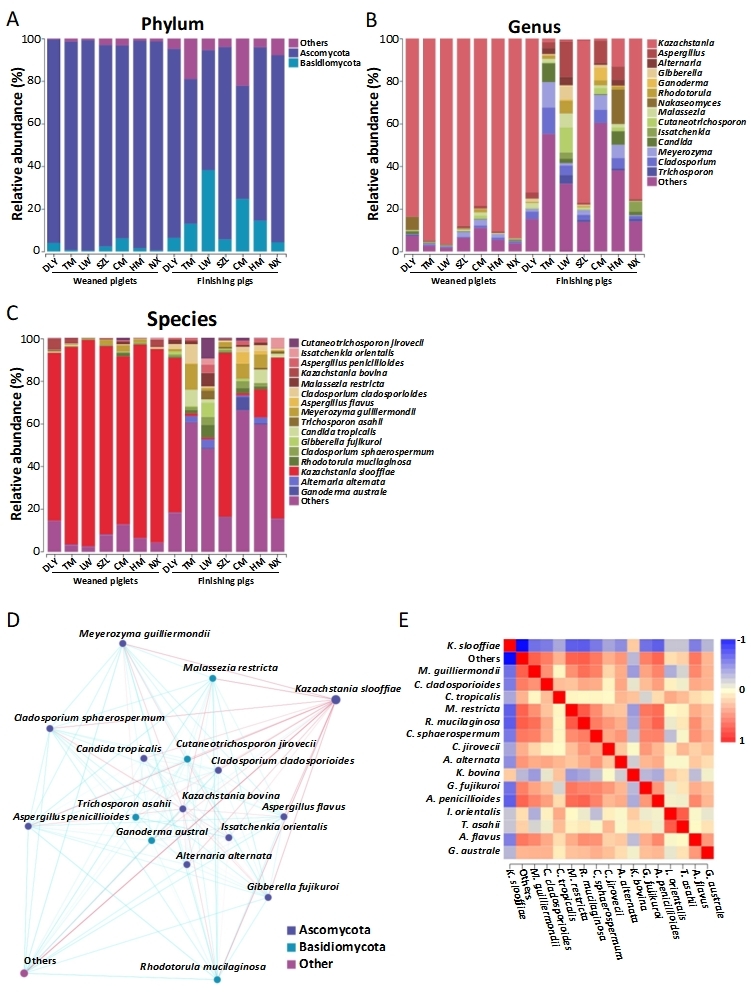南湖新聞網訊(通訊員 胡軍)近日,農業微生物資源發掘與利用全國重點實驗室、湖北洪山實驗室晏向華教授課題組在Microbiome雜志發表題為“Core-predominant gut fungus Kazachstania slooffiae promotes intestinal epithelial glycolysis via lysine desuccinylation in pigs”的研究論文。該研究鑒定了生豬腸道核心優勢真菌Kazachstania slooffiae,闡明其通過賴氨酸琥珀酰化修飾調控豬腸上皮細胞糖酵解代謝的作用機制,為理解生豬腸道優勢真菌與宿主的互作提供依據。
腸道健康是生豬健康養殖的前提,腸道微生物廣泛參與營養物質代謝和免疫調節等重要生理過程,目前發掘生豬腸道內原創性功能微生物資源較少,嚴重制約了功能微生物在生豬健康養殖中的高效利用。因此,深入發掘生豬腸道功能微生物并解析其作用機制對實施腸道菌群干預改善豬生長與健康具有重要理論意義和潛在應用價值。
生豬腸道內除棲息大量細菌外,腸道真菌亦是腸道微生物的重要組成部分,其對宿主生理的重要調控作用逐漸被重視。占核心優勢的腸道微生物在宿主腸道內的豐度較高,可與宿主形成較為穩定的共生關系,并參與宿主代謝的調控。蛋白質翻譯后修飾對細胞代謝具有重要調控作用,然而腸道真菌對宿主蛋白質翻譯后修飾的作用機制仍不清楚。
我校生豬精準飼養團隊綜合運用真菌ITS擴增子測序和宏基因組學技術解析了7個品種豬(即杜×(長×大)豬、藏豬、萊蕪豬、沙子嶺豬、從江香豬、環江香豬和寧鄉豬),共計56頭斷奶仔豬和56頭育肥末期豬的腸道真菌區系組成。發現不同品種豬的腸道真菌區系有明顯差異,但Kazachstania slooffiae是7個品種斷奶仔豬腸道內豐度均為最高的真菌。隨后從豬糞便中分離并鑒定了Kazachstania slooffiae,進一步開展了Kazachstania slooffiae與豬腸上皮細胞共培養的實驗。結果表明Kazachstania slooffiae可顯著降低豬腸道上皮細胞的賴氨酸琥珀酰化修飾水平,且顯著富集在糖酵解通路,進一步研究發現Kazachstania slooffiae通過激活SIRT5活性,降低賴氨酸琥珀酰化修飾水平,進而促進腸道上皮細胞糖酵解活性的作用機制。綜上,本論文系統解析了生豬腸道真菌區系組成,闡明了Kazachstania slooffiae可通過賴氨酸去琥珀酰化修飾促進豬腸上皮細胞糖酵解代謝的作用機制,為實施腸道菌群干預改善生豬腸道上皮細胞的能量代謝提供新思路與策略。

華中農業大學動物科學技術學院、動物醫學院博士后胡軍為第一作者,晏向華教授為通訊作者。本研究得到國家自然科學基金、博士后創新人才計劃、博士后面上項目的資助。
【英文摘要】
Background
Gut fungi are increasingly recognized as important contributors to host physiology, although most studies have focused on gut bacteria. Post-translational modifications (PTMs) of proteins play vital roles in cell metabolism. However, the contribution of gut fungi to host protein PTMs remains unclear. Mining gut fungi that mediate host protein PTMs and dissecting their mechanism are urgently needed.
Results
We studied the gut fungal communities of 56 weaned piglets and 56 finishing pigs from seven pig breeds using internal transcribed spacer (ITS) gene amplicon sequencing and metagenomics. The results showed that Kazachstania slooffiae was the most abundant gut fungal species in the seven breeds of weaned piglets. Kazachstania slooffiae decreased intestinal epithelial lysine succinylation levels, and these proteins were especially enriched in the glycolysis pathway. We demonstrated that K. slooffiae promoted intestinal epithelial glycolysis by decreasing lysine succinylation by activating sirtuin 5 (SIRT5). Furthermore, Kazachstania slooffiae-derived 5′-methylthioadenosine metabolite promoted the SIRT5 activity.
Conclusions
These findings provide a landscape of gut fungal communities of pigs and suggest that Kazachstania slooffiae plays a crucial role in intestinal glycolysis metabolism through lysine desuccinylation. Our data also suggest a potential protective strategy for pigs with an insufficient intestinal energy supply.
論文鏈接:https://microbiomejournal.biomedcentral.com/articles/10.1186/s40168-023-01468-3
審核人:晏向華